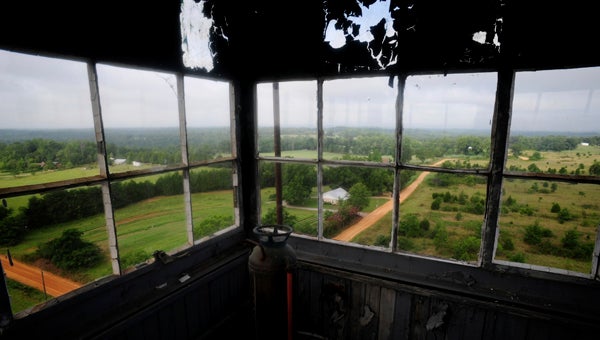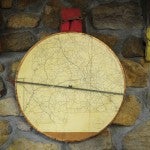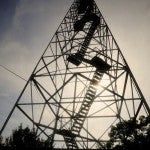
By Drew Granthum
Anyone in Chilton County, whether life-long resident or just passing through, is familiar with the massive peach tower that hovers over Interstate 65.
What most don’t realize is that the tower is not the first tower of significance in the county.
In fact, it’s not even the first to be called “Peach Tower.”

Instead, that distinction goes to one of two Chilton County Forestry Commission fire towers that were constructed in the 1940’s.
The first, which bears the “peach” name, is located next to the forestry commission building off County Road 423 in Clanton. The other is found along County Road 42 in the Union Grove Area.
Each served as a watchtower to survey the land for forest fires. The towers’ cabs came with a map located on an azimuth, which would help located the approximate position of the fire.
They would turn the azimuth toward the smoke and located the other tower, and triangulate to tell just about where the fire was,” said Brian Smith, Alabama Forestry Commission specialist. “They’d use a little math to figure it out.”
The Union Grove tower was erected in 1948, with the Clanton “Peach” tower in 1949. Each stands 110 feet from the ground to the cab of the tower, and has windows on all four sides, allowing someone to see all across the county.
For approximately 30 years, the forestry commission employed someone to post in the towers through the course of a day to watch for the slightest hint of a fire.
“They paid someone to sit up there all day everyday,” said Smith. “There was an actual position [just] for that.”
The towers were the main form of fire rescue, until modern technology took over.
“It’s obsolete,” said Smith. “Now we go off 911 calls with addresses. We go straight to the locations.”

Smith also said that working the tower wasn’t exactly an easy task to handle, either.
“It’s kind of rough on a person sitting up there all day in the heat,” he said “Not to mention when storms would come through.”
Although no longer manned, the towers still serve a very useful purpose in emergency response.
“They are used as antenna towers now,” said Smith. “We have the county bus shop repeaters, county fire association repeaters, and have had FBI and public safety repeaters on them.”
Although very sparingly, the towers still serve their original purpose from time-to-time.
In emergency situations, we will go and spot fires from them,” said Smith. “I doubt there will ever be a person actually man the firetower again.”
